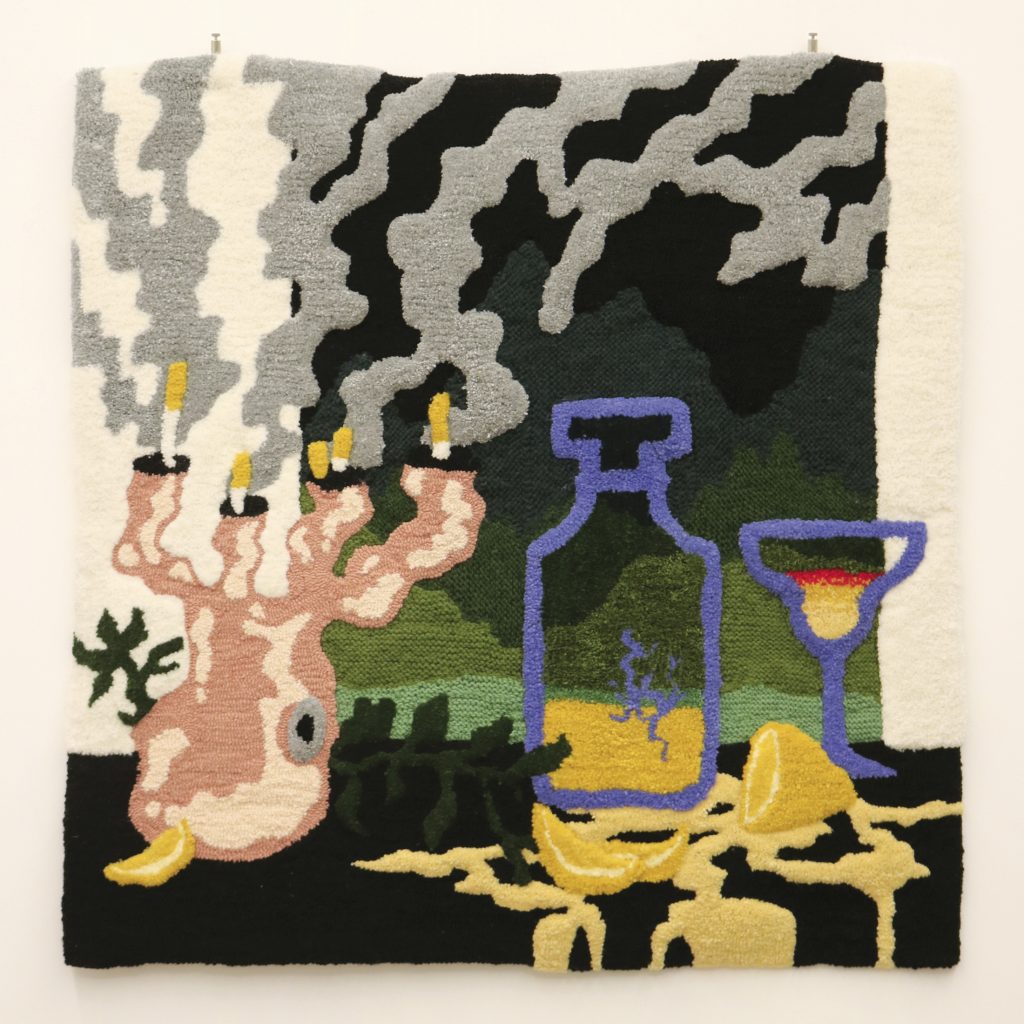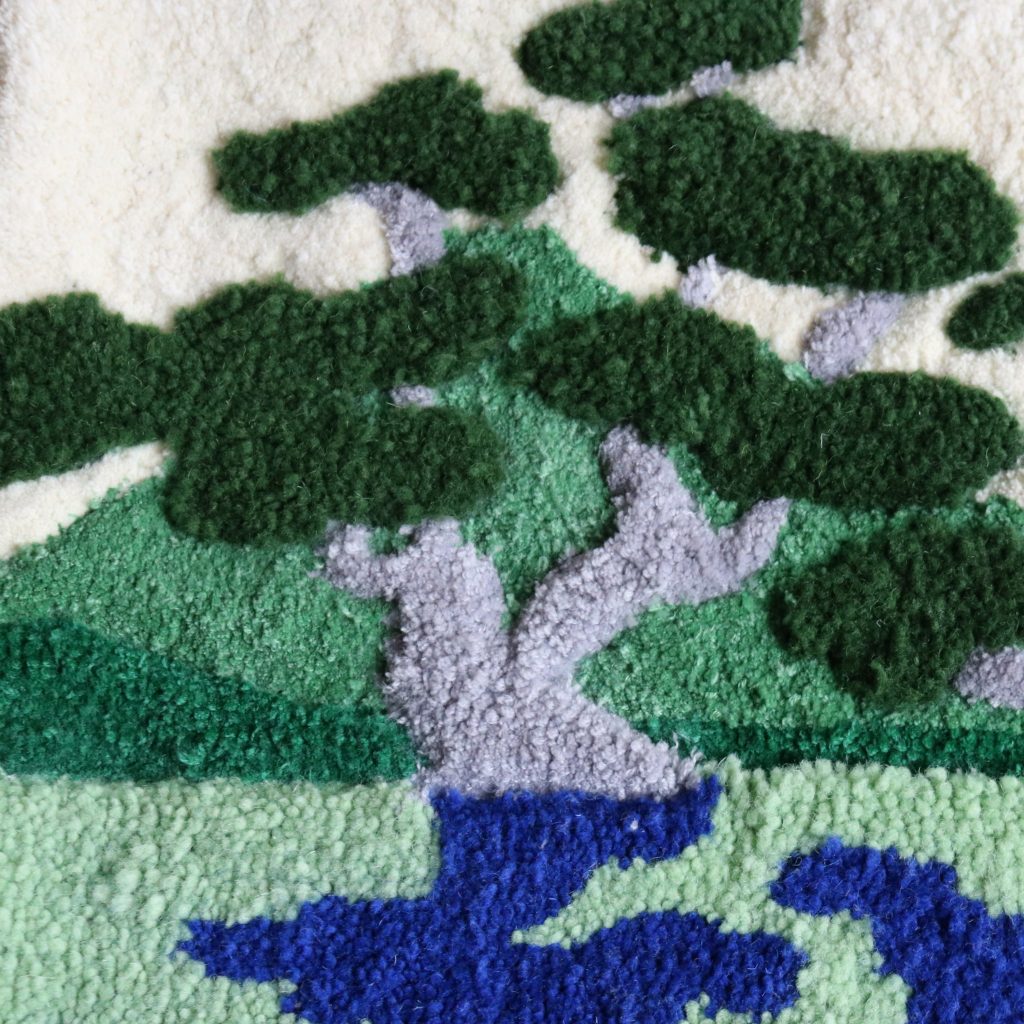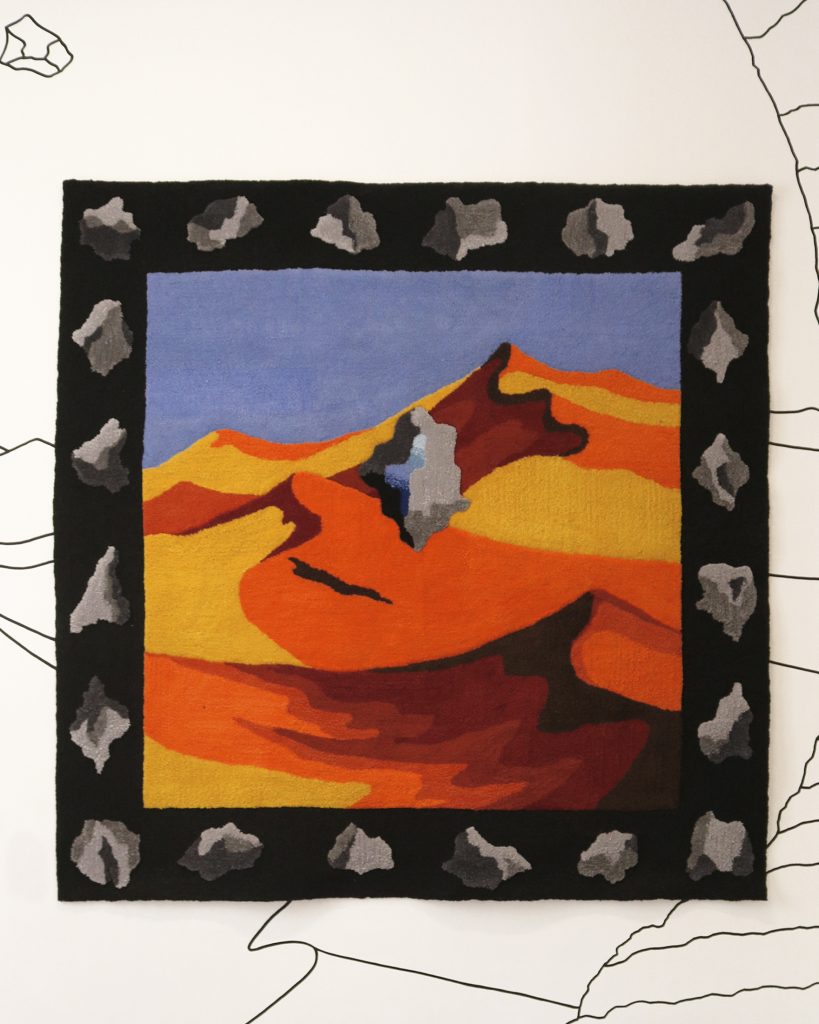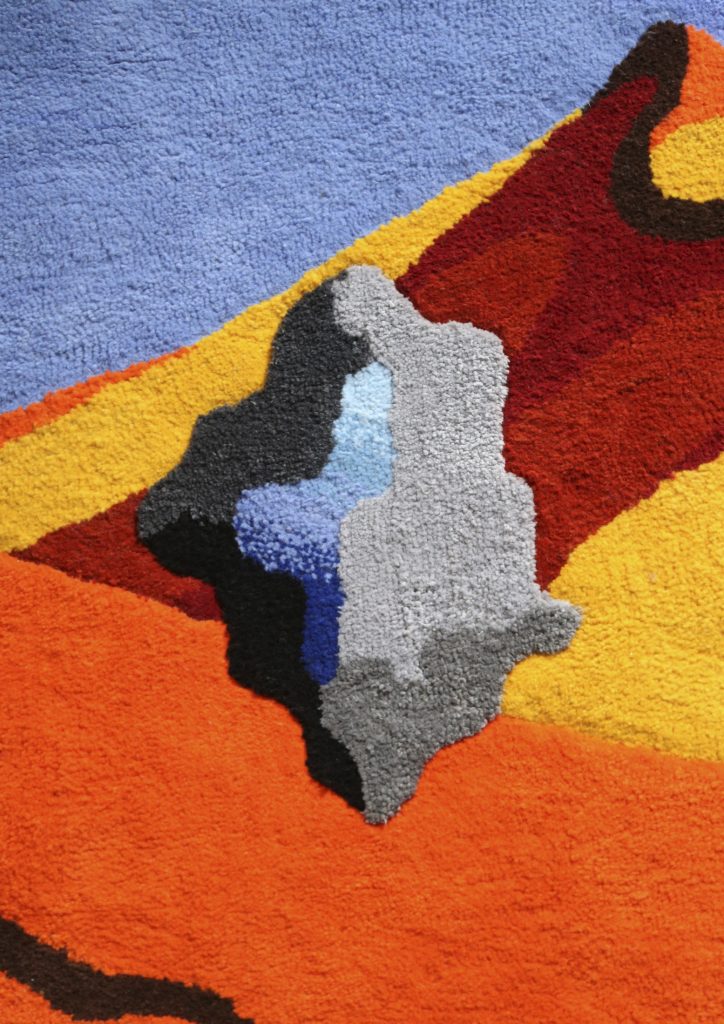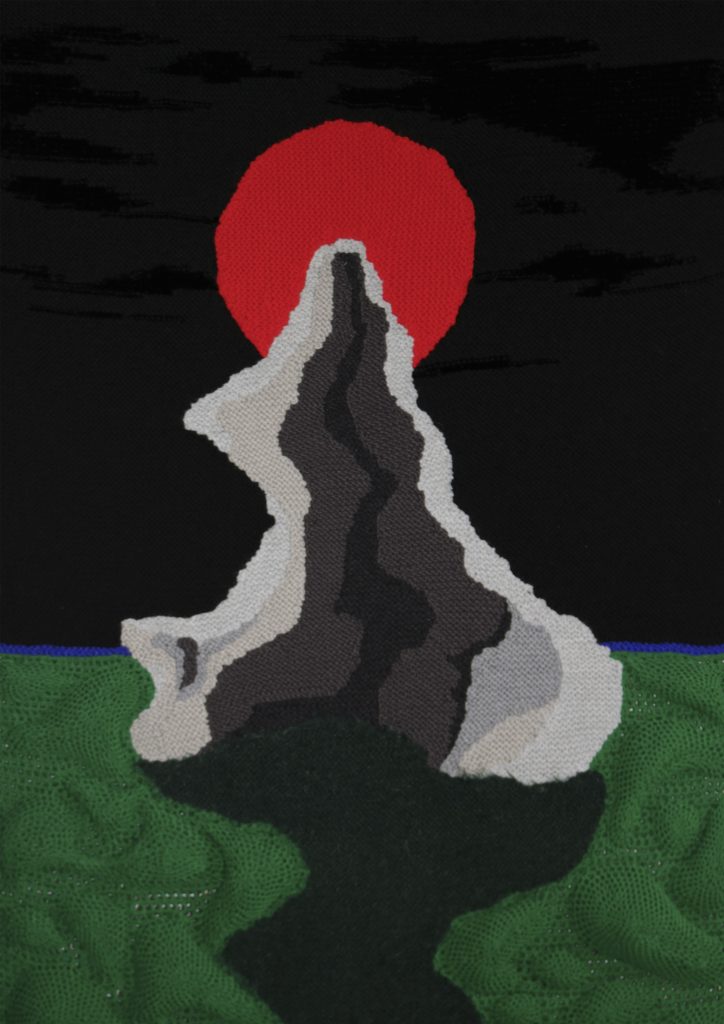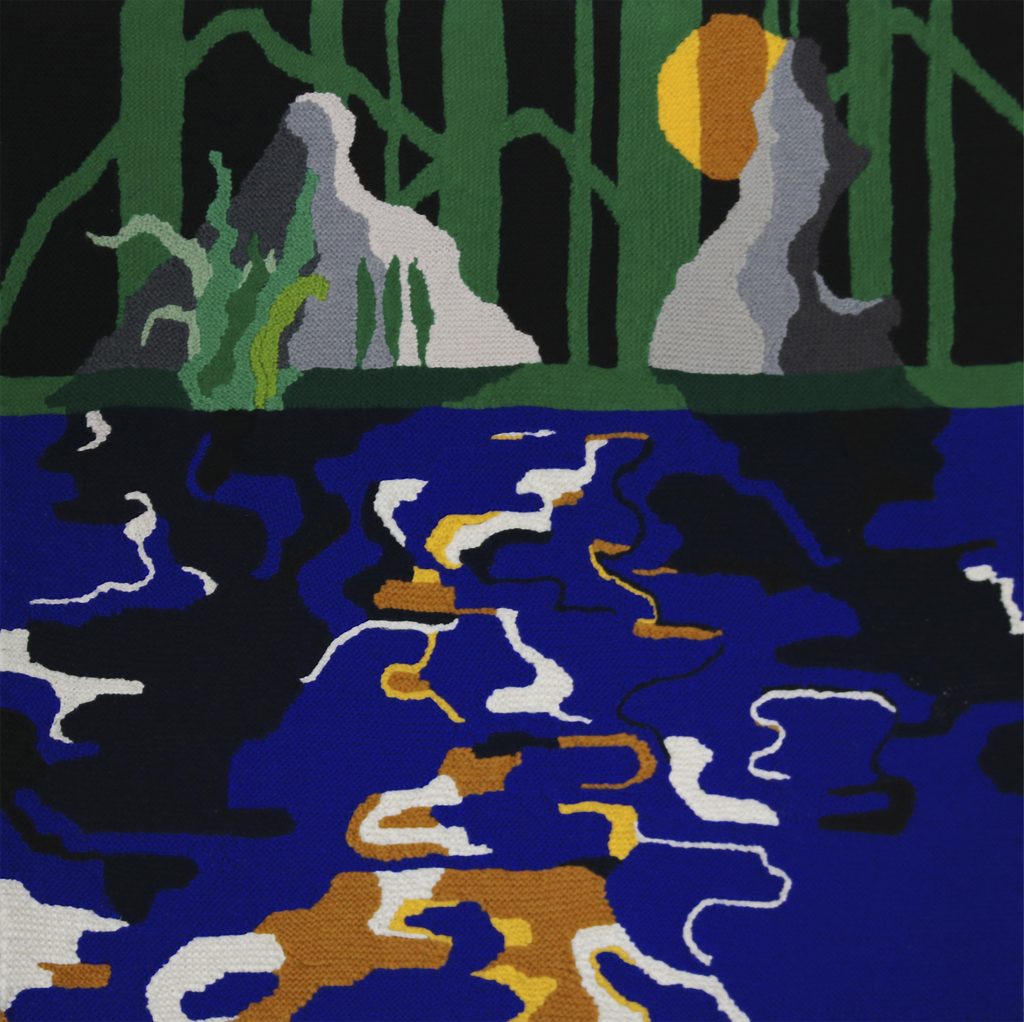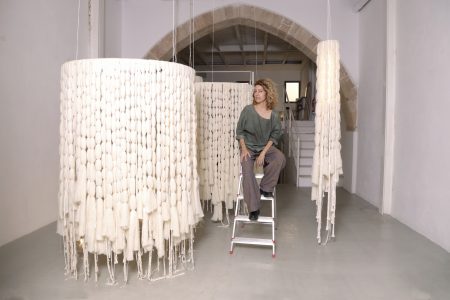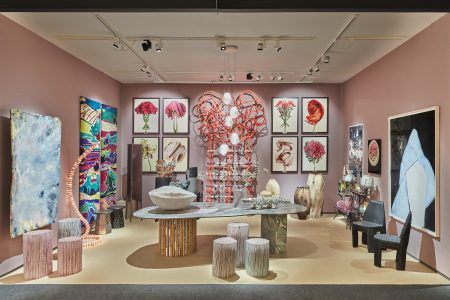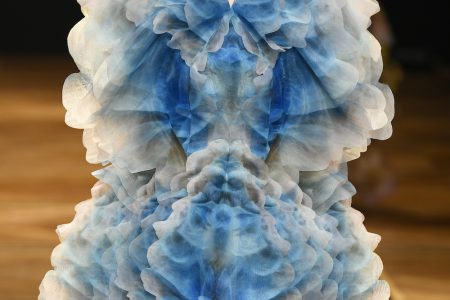Manon Daviet’s Knitted Landscapes
Using various textile techniques like knitting, embroidery and tufting, Paris-based textile artist Manon Daviet transposes her drawings into tapestries, creating what she calls “volume paintings”. Here, she talks TLmag through her multidisciplinary practice, finding inspiration in comic books and her embracing of mysticism in nature.
After completing her studies at the Duperré School in Paris, Manon Daviet quickly dove into her desire to knit a large tapestry. Having learned to knit and crochet in a sculptural way during her education, she created two entirely hand-knit pieces in quick succession: The Two Rocks Lake and Red Moon, inspired by a trip to Japan. Comprising multiple techniques in her textile creations, her interest in the great landscapes of her native Haute-Savoie, in comic books with their text bubbles and captions, in prints and picture books that sublimate nature, her tapestries captivate the eye and generate strong and invigorating emotions.
Tlmag: You began teaching yourself how to make tapestries several years ago. Could you tell us more about your way of working? What were the sources of inspiration that lead you to choose this medium?
Manon Daviet (MD): When I finished my studies at the Duperré School in Paris, I started an internship in leather goods at a fashion house. The vast majority of my tasks were on the computer, and I quickly realised that I wasn’t made for that job. I left the internship and I found myself at home with a desire to knit a large tapestry. This idea had come to me a year earlier during my studies, where I had worked with knitting and crochet in sculptural form – and so I started the tapestry with two pieces knit entirely by hand: “The Two Rocks Lake” and “Red Moon”, inspired by my earlier trip to Japan. I had practised knitting techniques quite intensely during my studies, so I was able to start on these first tapestries without a problem. The challenges arose later on – when I decided to mix these techniques with tufting. I first had to learn how to use the tool and research how to mix several textile techniques – all the while keeping an overall harmony in the work.
Tlmag: How do you integrate a pictorial dimension into your tapestries? Do you use your paintings as a basis for your textile creations?
MD: I don’t really see myself as a painter. When an image comes to me, I think of it almost directly in relief. I started painting when I began my first tapestry. I used it to scale my sketch before I transposed it into knitting. Strangely, I always had a hard time painting and getting started on a large white canvas. Using this as an intermediate step to my final goal relaxed me. It enables me to compose my image and create colour combinations, even though my tapestry will not look like the painting in the end. I use the expression “volume painting” because in my work I like to play on factors such as the techniques and their different points (tufting, mesh, embroidery, etc.), the relief, and the density, thickness and texture of the threads. Furthermore, wool reacts in a particular way to light; a bit like it’s absorbing it. The colours are more intense, variable, textured, and offer another visual and tactile dimension and perception compared to the painting that I used as a sketch.
TLmag: Did this understanding of tapestry through painting change your perspectives on how you treat each of these media individually? Do you paint today without moving towards textile, and vice versa? Do you always prefer to use them together, or do you tend towards one of these two artistic fields?
MD: The influence goes in both directions. Since I started my tapestry work, I am drawing more and more, and have more interest in various fields of art and design. By practising and refining my own tastes, I have drawn closer to an aesthetic characterised by a figurative style, with simplified forms punctuated by dense and vibrant colours, and an often-flattened perspective. So, I would say that, firstly, drawing and painting are clearly the basis for my tapestries. Conversely, my textile practices guide how I paint. Since painting and drawing are preparatory steps, I think of them according to the textile techniques that will follow. I avoid too-fine lines, shapes with blurred outlines, and large variations in tones. Let’s say that my research is more about the story I want to tell, about the composition of the image, the treatment of forms and the colourful ambience than about the painting effects and techniques.
TLmag: You seem to focus on more classical subjects for your works, mainly landscapes or still lifes. However, your use of bright colours, dense shapes and repetitive patterns is reminiscent of comic books.
MD: My mother has a large collection of comic books, mainly science fiction, so I learned to appreciate the drawing style quite early on. The comic that I really loved from an aesthetic and narrative point of view is “The Worlds of Aldebaran” by Luiz Eduardo de Oliveira (aka “Leo”). In the comic, and in general, I am very attracted by the bright colours and sharp shapes with well-defined outlines. The design has a kind of “efficiency” which gets to the point and, with a single image, manages to project us into a world, generate a story, develop an atmosphere and even visually create a sense of movement. This field of art also attracts me from a graphic point of view by playing with typography (for example, a “zooming” typography to evoke an increasingly loud sound), by the way texts or onomatopoeias can sometimes perfectly mould the image, and quite simply by the plays of composition and box size that can zoom in on an important detail of the story, or conversely immerse the reader in full pages of landscape. It is an extremely complete and rich medium that I would like to use more to find inspiration for creating large narrative tapestries. Besides my appreciation of comic books, I am also very interested in Japanese prints, and Egyptian, Persian and medieval painting. Scientific books, with their often-colourful diagrams, frontal images and subjects reduced to their simplest form to enable them to be analysed, broken down and instructive, are also a rich source of inspiration.
TLmag: An almost constant element in your work is your fascination with the beauty and mysticism of nature. How do you carry out your research? Do you immerse yourself in several subjects at once?
MD: I lived in the countryside in Haute-Savoie, near Annecy, until I was 18 years old. My childhood home is surrounded by forests, mountains, fields and cows so, firstly, I think that these landscapes are very much a part of me. This source of childhood inspiration has been added to by trips in France and abroad, by songs, articles, films, exhibitions, books, etc. There is really no specific protocol or field. Everyone filters what they see based on what they want to retain. From the moment I started to draw and create my tapestries, I began to look differently at what surrounds me, to reflexively think about how to position new elements. Thus, The Two Rocks Lake, my first knitted tapestry, is inspired by Japanese landscapes; Les roches du ciel tapestry, in warm and bright colours with a meteorite in its centre, comes from an exhibition at the Museum of Natural History in Paris; Fire <dance represents a memory of a night I camped in the high mountain area of the Lac d’Anterne watching shooting stars from the foot of the majestic Rochers des Fiz with a panorama of Mont Blanc; La conspiration des vaches represents the night view from my father’s house, where I imagined the cows in the neighbouring field would meet under a full moon to discuss a secret escape plan. Some tapestries are memories, others are inspired by what I see or stories I tell myself, and still others represent fantasies of landscapes in which I would like to immerse myself.
TLmag: With the COVID-19 crisis, as people have more time and are forced to think about what surrounds us, we are seeing a return to the manual arts such as sewing or knitting. Have you noticed this yourself? Do you believe that this confinement will lead people to rethink the importance of the textile arts?
MD: I have indeed noticed this strong attraction for artistic practices since the beginning of confinement. I was quite surprised to see how the quickly the shelves of hobby supplies were emptied. I think that the return to these practices can be positive for the art textile community, certainly; but particularly in how we consume objects and time. These techniques – whether sewing, embroidery or knitting – are the fruits of patience and perseverance: two fundamental human qualities in general, but ones that resonate particularly with today’s events. The world is moving quickly and these manual processes let us slow down time, question how textile objects are made, and above all savour the simple happiness of making things ourselves. As for the textile arts, I don’t really have an idea about the direct impact of the crisis. I imagine that we will see the conversion of many companies and workshops in the coming years. Some people will undoubtedly embrace the textile art world by reinterpreting existing techniques or by expressing their creativity using new techniques. Such new approaches will enrich this artistic field, and perhaps give it a little more weight in the contemporary art world.
